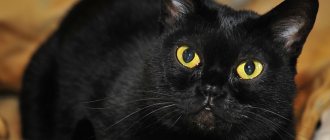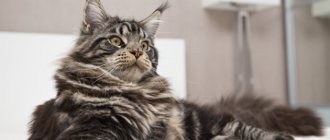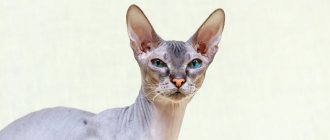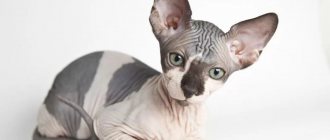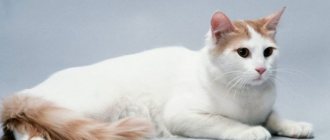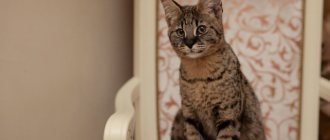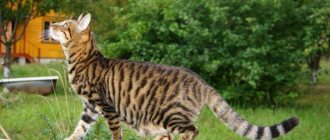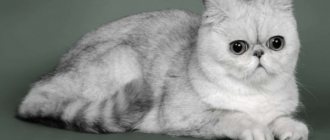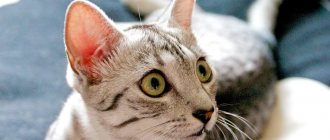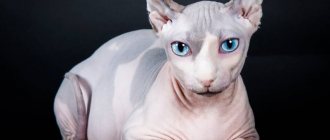basic information
The sacred Birman cat is of medium size, light weight, and belongs to the long-haired type. Beautiful appearance matches a pleasant character.
| Name | sacred birman cat |
| Country of origin | Burma (Myanmar) |
| Type | long-haired |
| Weight | 4-6 kg |
| Age | 12-18 years old |
| EMS code | SBI |
Estimation of breed characteristics
| Adaptability | ***** |
| Problems with shedding | ** |
| Tenderness | ***** |
| Need for communication | ***** |
| Health | *** |
| Grooming | * |
| Attitude towards children | **** |
| Get along with dogs and other pets | **** |
| Activity | ***** |
| Intellectual abilities | ***** |
Key features in education
All Burmese cats are medium in size but have a strong body. Representatives of the breed are very hardy and have a calm, peaceful character. The main nuances include the following indicators:
- Inexperienced owners should know that cats have a friendlier character than cats.
- The Burma gets along well with other pets, but there is a place of jealousy in relation to the owner.
- Curiosity is characteristic of all Burmese cats, at any age. For this reason, all aggressive household liquids and sharp objects should be removed from reach. In everyday life, you can observe how a pet chases its owner until it achieves the desired result. Perseverance is another interesting character trait of this amazing cat.
- Cats of this breed do not tolerate loneliness very well, constantly demanding attention.
The pet's color changes as it gets older. All Burmese kittens are snow-white in color, but with age, part of the fur turns brown.
Description of the breed
These are not the largest representatives of the cat family. A cat weighs about five to six kilograms, and a female cat weighs up to four. Their life expectancy is quite respectable, they live about fifteen years and longer if the animal is provided with good conditions and proper maintenance. High-quality nutrition, coat and ear care, vaccinations, and hygiene are of great importance. He is famous for his flexible character and his intellectual abilities are quite high.
Story
The official history of the sacred cat breed is quite long. It was first recognized in France about a century ago - in 1925. In 1959, representatives came to the United States, and by 1967 they received recognition from various associations. In the 70s they became known in Europe, Australia and New Zealand. They came to Russia in the 90s.
There is a beautiful legend about the appearance of these cats and their acquisition of sacred status. The cat Singh, who lived at the temple of the Indian goddess - the mistress of souls, stood up to protect the priest who died at the hands of bandits. The intervention did not save the priest, but the goddess appreciated Singh’s courage.
Her long white fur was given a golden hue, and her amber eyes became bright sapphire. The edges of the paws remained boiling white, symbolizing the purity of the deceased monk. These changes affected other temple cats, which surprised the servants who returned to the temple after the attack. The legend explains why it is called “sacred” or “holy”.
According to felinologists, the sacred Burma is a product of crossing Angora cats with Siamese. Like Balinese cats, which have a similar origin, they have a soft, silky coat. It is not known whether the breeding process was planned or accidental, or when exactly the mating occurred. The probable place of origin of the breed is considered to be southeast Asia.
There is a version that European individuals took part in the appearance of this variety; this happened in France. Gordon Russell and Auguste Pavy handed over the blue-eyed offspring to the ministers, expressing their gratitude. Regardless of the story, the result was amazingly beautiful cats with unique personalities. Another famous breed from this region is the Burmese, but it looks completely different, it is a short-haired beauty.
Standard
The requirements for the exterior are quite strict. The main parameters of the breed standard are presented in the table:
| Category | Description |
| Wool | Beige, has a golden hue, silky, soft, medium length, on the muzzle there is a “Siamese” mask, short fur, on the paws there are white “socks”. Around the neck, elongated hairs form a resemblance to a lion's mane, and the undercoat is scanty. |
| Muzzle | Heart-shaped, with high cheekbones, soft features. |
| Eyes | Intense blue color, oval, symmetrically located. |
| Forehead | Slightly rounded. |
| Nose | Medium size, with a slightly rounded tip, in line with the middle of the chin. |
| Ears | They have the shape of an isosceles triangle, medium size, set with a slight bevel, the tips are rounded. |
| Tail | Long, can reach the shoulder, fluffy, shaped like a feather. |
| Paws | White socks are short and equal in length, with a clear pattern. On the front legs they end up to the carpal pad, on the hind legs - up to the hock joint. The socks start from the toes, the pads are pink. |
Disadvantages of appearance:
- short stature;
- excessively long limbs;
- rough, too long or short coat;
- presence of white spots;
- insufficiently contrasting color;
- close-set, small or too light eyes, squint;
- irregular muzzle shape, triangular or round;
- chin slope;
- long or shortened nose;
- ears: long or pointed, standing close together, curved back, folded;
- short tail;
- sharp tip of the tail;
- any asymmetry of the “socks”, their absence or excessive length.
Taken together, the regular features of the Burma saint make her appearance very harmonious and attractive, at the same time sweet and bright. Clear blue eyes add some mystery.
Colors and coat
The coat of the Holy Birman is of medium length, the undercoat is scanty. This makes it easier to care for them and clean the room. The colors of these cats are varied, thanks to developing selection. Several varieties are considered acceptable. Like Balinese cats, these are color-point cats with a diamond-shaped dark mask on the face, which is separated from the ears by patches of light fur.
Appearance of a Burmese cat
Burmese cats are believed to be endowed with extraordinary beauty. In 1967 they were recognized by the American Association.
The appearance of the Burmese cat is considered the standard of beauty. Over time, the breed began to develop rapidly, and the palette was supplemented with more and more new coat colors. The Burmese cat has royal manners. These are very neat, gentle and calm cats. Let's take a closer look at the description of the breed and the character of the Burmese cat.
Popular colors
The main thing to consider when considering a cat's fur is the absence of defects. No extra spots, only solid color, white paws and sky blue eyes. Dark areas are concentrated on the muzzle, connecting to the ears, and also on the tail.
The Sacred Birman usually has a standard coat color - beige with a hint of chocolate. But the cat also has many types of its other colors:
- Dark brown point is the most common coat color. The brown shade should be richer. Also, a brown tint may appear on the coat in the form of stripes.
- Blue point - this shade is more like silver or gray. The classic color is white, but the blue color appears on the face in the form of a diamond and on the ears. The main thing is that the blue color is uniform. The silver color appears around 2–3 years of age.
- Chocolate is not as rich as brown. The most important difference from other shades is that the tail must be completely chocolate-colored. There is also a diamond-shaped chocolate color on the face.
- Lilac is the most noble, delicate and beautiful color. Its advantage is that the color gives off a mother-of-pearl appearance. There are individuals with purple stripes.
There are also other mixed shades:
- Brown-beige.
- Chocolate cream.
- Dark brown stripes.
- Silver stripes.
- Chocolate point stripe.
The most common color: beige-chocolate color.
Head and muzzle
The shape of the head of Burmese cats is round, but slightly reminiscent of a triangular one. And the skull itself is strong. There are cheeks that have a fluffy round shape.
The ears are small, stand neatly, the ends are slightly rounded. Sometimes you can see tassels.
The eyes are bright, round, sky blue or royal blue. In very rare cases, there are cats with golden eyes.
The nose is quite wide and large.
The chin is pointed and stands out easily.
Almond-shaped eyes will captivate everyone who looks into them.
Frame
The Burmese cat's body is slightly elongated in length. When reaching adulthood, the breed is of medium size and weighs approximately 3–4 kg. Males weigh a little more, about 5 kg. The muscles of a cat's body are very flexible.
The paws, when they reach their size, do not become long, but acquire a wide shape. The paw pads are usually bright pink.
The tail is very fluffy, making it appear small.
You can see the cat in more detail in the black and white image.
Burmese cat diagram.
Coat
The Burmese cat breed is highly revered for its fluffy and attractive coat. This is because they are of medium length and have a short undercoat. It is very soft to the touch, like silk. On the muzzle there is slightly less hair than on the body, and on the cheeks it lengthens, smoothly moving onto the collar. The cats themselves and their owners do not suffer from mats. On the tummy the fur may be slightly rounded. The hair is longer on the back and sides.
Fluffiness of the coat will not cause you any problems.
Difference between Burma and Burmese
Despite the fact that these two names can be confusing, they are still completely different cats. The main difference between a Burmese and a Burmese cat is that you will not find white socks on its paws. Also, the Burmese has dark markings on its face and paws. The eyes of Burmese cats are more brown, and they are set wider. You can see it better in the picture.
The Burmese cat can be immediately identified by its fur.
Character
The sacred Burmese cats inherited the best features from their conditional ancestors, Siamese and Persians. They are both loving and unobtrusive, not as phlegmatic as the Ragdoll, because despite their softness, they have a bright character. The pet loves its owner very much, but has a positive attitude towards all family members, dogs, and other pets.
He loves to sit in his arms, but if he understands that a person is busy, he will not impose himself, unlike the Burmese, which is distinguished by its cheerfulness. Burma will wait for a favorable moment and will stay somewhere nearby. They are not bossy and demanding like Siamese cats, but they have inherited a fairly high level of intelligence. By nature, Burmese are very curious, actively exploring the surrounding space.
Character of Burmese cats
Burmese representatives of the cat family attract not only with their charming appearance, but also with their impeccable character, harmoniously combined with refined manners.
Cats of this breed have a very gentle voice, but are not talkative. They are moderately curious, love order and silence. They enjoy spending time in the company of their beloved owner and, thanks to their developed intelligence, they understand his commands well and quickly learn new things.
Burma is a real intellectual! An intelligent and affectionate cat behaves decently in the presence of guests. She will never offend a child, which is justified by her balanced temperament and ability to present herself only from the good side.
Kittens of the Burmese breed are playful, love outdoor games and the attention of household members. They enjoy spending time in the arms of their owner, but they cannot be called intrusive. They understand the owner’s mood and quickly become attached to their new family and home.
The friendly Burmese gets along well with other pets and tries not to get into conflict situations with its fellows. Character advantages also include the restraint and good manners of a purebred pet.
If you decide to get a Burmese cat, we are sure that this cute animal will bring only joy and favorable emotions to your home!
Peculiarities
There are many positive features. Their balanced character plus high intelligence makes them friendly and calm. They don’t remember insults, are easy to train, develop good habits, and are non-aggressive. The almost complete absence of undercoat makes regular grooming easier. Blue-eyed pets do not shed as much as other fluffies. The coat is delicate, silky, and easy to comb, unlike the Neva Masquerade, a long-haired breed with a similar color.
The disadvantages include a number of points:
- Loud noise is annoying, you need a quiet place to rest.
- They resolutely refuse food they don’t like.
- Leaving someone alone is a bad idea and can cause stress.
- Drafts and coolness can cause disease due to the small undercoat.
- The cost is high.
Negative reviews are almost never found. A friendly, handsome guy with a bright appearance lives up to his reputation as a good pet. If a small child causes severe pain, the mustachioed beauty is capable of displaying aggression.
“Many owners note that such kittens are playful and restless. By the age of two or three, they acquire some solidity, their delicacy becomes more obvious. Throughout their lives they maintain a high need for communication and curiosity.”
Breed standard
The light beige color of the coat with a golden tint is complemented by the characteristic “mask” on the face of the Siamese breed and white “gloves” on the paws. The coat is medium length, silky, soft, requiring regular brushing to prevent tangling. The hair on the muzzle is short, it is slightly longer on the cheeks, and the thickest around the neck is the “lion’s mane.” Since the undercoat is poorly developed, the animal is sensitive to low temperatures.
According to the official version, the breed appeared at the beginning of the twentieth century in France by crossing Persian and Siamese cats.
The characteristic color is color point, in which darker colored areas stand out on the light body: muzzle, ears, paws, tail, genitals. The “mask” on the muzzle is diamond-shaped, clearly separated by a light space from the ears.
In the process of continuous selection, the breed acquires an increasing variety of colors and shades of coat.
Maintenance and care
Caring for them is no more difficult than for other long-haired pets. There are procedures that should be performed regularly. If you follow all the rules, the fluffy will be healthy and beautiful. Cannot be kept in cool, ventilated areas. Protective bars on windows are required. It is recommended to brush your teeth and ears every two weeks. The claws are trimmed and trained to use a scratching post. Walking outside is recommended to be done under supervision so that the cat does not get lost.
Grooming
No special grooming is needed. A good salon will find something to offer the owner, but many manage on their own:
- comb long hair every two to three days;
- During shedding, daily brushing is recommended;
- bathe monthly depending on the degree of contamination;
- the use of special shampoos and other hair care products is allowed;
- brush your teeth and ears twice a month or weekly;
- When dirty, the corners of the eyes are cleaned with a cloth soaked in an aqueous solution of vinegar (1:1).
A smooth-haired cat requires almost the same care, in addition to combing. There are special products for cleaning ears and eyes that can be purchased after consulting a veterinarian. Pets accustomed to water from an early age can easily tolerate bathing. To reduce stress, it is recommended not to immerse the animal in a container of water, but to use a hose or shower head.
What to feed
How long a Burmese lives depends directly on their diet. It is allowed to use ready-made food, dry or canned. A diet consisting of natural products must be balanced.
Natural food
Such nutrition completely excludes the use of dishes prepared for people. Salt and any spices are not allowed. Meat makes up 70% of the total diet. The daily norm for an adult is about 200 g. All products must be fresh and of high quality. You can give:
- chicken, rabbit, beef, turkey and other lean meat, which is frozen, treated with boiling water, and then boiled or given raw;
- boiled sea fish, from which the bones have been removed (twice a week or less);
- boiled vegetables mixed with meat, cereals;
- boiled or raw eggs (twice a week);
- green grass (sold in pet stores).
Smoked meats, sweets, fried and fatty foods are strictly prohibited. Adults are not given milk.
Ready food
Dry or canned food must be of exceptional quality, Premium, Super Premium level. Inexpensive food contains additives that can cause an allergic reaction and negatively affect health. This affects the condition of the coat, the functioning of internal organs, metabolism, and the endocrine system.
Experienced breeders recommend using products from trusted brands:
- Royal Canin;
- Orijen,Hill's;
- Akana;
- Felidae
These are balanced formulations containing essential nutrients, microelements, and vitamins. When using dry formulas regularly, you should provide free access to clean, fresh water with a low content of mineral salts. As a reward, you can offer canned food, low-fat boiled fish, fermented milk products, and some shrimp.
Features of feeding
An undoubted positive feature is the ability to control the feeling of satiety. The food can be left freely, there is no danger of overeating, and obesity is excluded. You cannot use low-quality food, such as Whiskas or KiteKat. There are a lot of useless, cheap ingredients, flavorings that cause urolithiasis, gastrointestinal problems, dermatitis, and other serious diseases.
The money saved on food will have to be used to pay for veterinarian services. It is not always possible to regain lost health. Despite their sweet nature and commendable self-control while eating, they are picky in this area. If the animal in the nursery has already been accustomed to a certain type of food, it is recommended to continue feeding it with products of that particular brand.
Features of feeding and diet
The cost of keeping a Burmese is quite high, since it does not favor dry food and canned food. Natural feeding is often more expensive, since in addition to food you have to buy vitamins. It is also worth considering the fastidiousness of the animal. Before you understand what to feed your pet, you will have to sweat in trying to recognize his favorite dish.
Of course, there are advantages to owning a Burma. She never suffers from obesity, because she knows her norm. Purebred pets will not eat everything that is poured into a bowl if the feeling of fullness has already set in. When preparing your diet, follow the general recommendations:
- Choose lean meats: chicken, rabbit, turkey. Pork and lamb are harmful to the kidneys and liver. Protein should form the basis of the diet.
- Use natural fermented milk products. Milk can only be given to kittens. After 1 year of age, all adult animals develop lactose intolerance.
- Supplement your main diet with a small amount of cereals and vegetables.
- Avoid any products that contain natural or artificial colors. They can change the color of the fur coat to a darker shade.
Feed adult pets twice a day, leaving no more than 250 g of food at one time, and even less dry food. It is enough for kittens to give 150 g of food 4-5 times a day. Calculating portions is necessary to ensure that the food does not spoil in the bowl. Remember that natural products are removed immediately after feeding.
Health and illness
A purebred individual without health problems is a rare case. Sacred Burma has its weak points. Here is a list of diseases to which they are predisposed:
- Congenital hypertrophy - manifests itself in the appearance of baldness, causes immunodeficiency, and ends in death.
- Corneal dermoid, in which a thin layer of skin or hair forms on one or both eyes, is corrected surgically.
- Spongiform degeneration is a disease of the central nervous system, manifested by problems with coordination, weakness of the limbs, and causes complete or partial paralysis.
- Body trembling is a problem typical for newborn kittens in the first ten days of life, disappears by the age of three months, the cause of the symptoms has not been established.
- Elevated creatine levels are a common problem in individuals with kidney disease.
- Hypertrophic cardiomyopathy, expressed in increased drowsiness, shortness of breath, occurs rarely.
A hereditary Burmese disease is corneal dermoids. A course of antibiotics and special drops prescribed by a veterinarian solves the problem. Veterinarians note that serious problems arise under the influence of genetic factors. Proper care prevents illness. To avoid periodontal disease, brush your teeth regularly.
“Regular ear care does not protect against otodectosis caused by mites. It is necessary to monitor behavior, especially after being outside. If there are dark scales in the sink, the cat shakes its head, and itches frequently, it’s time to go to the clinic.”
An important point is timely vaccination. Vaccinated from:
- depriving;
- rabies;
- plague;
- panleukopenia;
- chlamydia;
- viral leukemia;
- rhinotracheitis.
The schedule is agreed upon with the veterinarian, vaccination begins at approximately four to five months of age, sometimes closer to one year of age. Over time, revaccination will be required. It is necessary to sterilize cats that are not intended for breeding to avoid complications caused by “empty” heats.
“The owner should note changes in condition and contact a veterinarian immediately. Early diagnosis allows you to quickly deal with the problem. With a balanced character, changes in behavior will become immediately obvious.”
Diseases and life expectancy
Burmese cats live on average from 10 to 15 years, there are also long-livers, over 20 years. This breed has a congenital predisposition to certain diseases:
- Hypertrophic cardiomyopathy - occurs as a result of inheritance of the disease in an autosomal dominant manner. It is characterized by myocardial damage with the gradual formation of heart failure, thrombus formation and, as a result, death.
- Kidney disease - the most commonly diagnosed disease is urolithiasis.
- Spongiform encephalopathy is a degenerative change in the substance of the brain, in which neurological pathologies are observed, paresis and paralysis of the limbs are possible.
- Corneal dermoid is a tumor that occurs as a result of impaired tissue embryogenesis. The disease manifests itself at a young age, with a tumor forming on the mucous membrane of the eyes, which looks similar to the skin. It can be treated through surgery and does not pose a danger to the animal if promptly contacted by a specialist.
Pregnancy and childbirth
It is recommended to breed cats every 8-10 months, not more often, so that the body has time to recover, which increases the possibility of getting healthy offspring. The optimal time for the first pregnancy is at one year of age or a little later, when the female can safely bear healthy and strong kittens.
The onset of pregnancy after mating is indicated by obvious signs:
- behavior changes;
- vomiting appears;
- appetite increases.
They appear about three weeks after mating. If a delicate beauty suddenly becomes irritable and avoids communication, kittens will probably appear after about 65 days. The owner’s task is to provide proper nutrition, conditions for childbirth and care for the offspring.
Food should contain an increased dose of proteins, vitamins and essential microelements. Before giving birth, anxiety will increase, the expectant mother will begin to look for a secluded and comfortable place. A fairly spacious box with soft bedding made from natural materials is ideal. Complications during childbirth are rare, although you should not leave the animal alone. In due time, 4-6 kittens appear.
Characteristics of the breed
To understand how unique the Burmese cat is, you should familiarize yourself with the history of the breed. And also study the features of appearance, character and possible coat colors.
Burmese kittens are not cheap, and the information received will help you recognize a purebred representative by its characteristic features.
History of the breed
According to generally accepted legend, the Burmese cat first appeared on the Indochina Peninsula in the state of Burma, which gave the name to the breed. The animal was the guardian of the temple, for which it received its second name “Sacred Burma”. In the 30s of the last century, an American millionaire, traveling around the East, noticed a cat of an unusual color and was fascinated by it. For a decent amount of money, he purchased several kittens of this breed. This is how the Burmese cat was brought to America, and then spread to European countries.
According to the official version, this breed was obtained by crossing a Siamese and a Persian or Angora cat, which helped combine their best qualities. As a result, a breed was developed that has a unique appearance and calm character.
The Cat Fanciers' Association officially confirmed the breeding of a new species of cat in 1967. These were mainly animals distinguished by their brown color. But thanks to further selection, blue cats were soon obtained. This only spurred new experiments and made it possible to obtain a wide variety of colors for the Burmese breed.
Appearance
Cats of this species are characterized by a compact and strong build (the difference between the Siamese and the Siamese is that the cats are thin). The Burmese body is low-set and has a slightly elongated shape. The height of the animal at the withers reaches 30 cm. The weight of an adult animal varies from 3 to 6 kg, since cats are much larger than cats. The neck is elongated and elegant, the chest is harmoniously built and has a rounded profile in profile. The paws are strong, massive, rounded with tightly clenched toes. The hind limbs are slightly longer than the forelimbs. The tail length is average, but shorter than that of the Siamese breed and longer than that of the Persian. The hair at the base of the tail is thinner and noticeably thicker towards the tip.
The Burmese cat differs from the Ragdoll in that the latter have the ability to relax the muscles as much as possible, which is why they received the name “rag doll”.
When examining the animal's head, you will notice that it is slightly rounded in front, behind and in profile. The ears are set wide apart; when viewed from the side, they appear to be tilted forward and have a rounded tip. The Burmese breed has wide cheekbones and sunken cheeks, which is a disadvantage. The chin is strong with a well developed lower jaw. The Sacred Burma's bite is naturally correct.
The eyes are widely spaced, their upper line is slightly slanted towards the nose, which is characteristic of the oriental type, and the lower line is rounded. Their shade varies from blue to gray-blue. In kittens, eye color can change several times, but by the age of four months a permanent pigment is established. The nose is medium in size, rounded at the end. When viewed in profile, it forms an ideal vertical line with the chin.
The Burmese's coat can be either medium-length or longer, but at the same time it is silky and pleasant to the touch. A special feature is that the wool does not get tangled. The coat is straight throughout the body, but in the abdominal area it can curl into light curls. A luxurious jabot is formed around the neck of the Burmese, it looks very elegant.
Varieties of color
At birth, kittens have a white coat, and by six months of age some of the signature coloring appears. The final shade of the coat is established by the age of three.
Saturation of color in adult cats is present on the ears, face, tail and mask around the eyes. A characteristic difference between the Burmese and the Siamese breed is that the contrasting shade becomes significantly lighter towards the belly and chest.
The main distinguishing feature of the Burmese cat is the color of its paws. On the forelimbs, white gloves end in a straight transverse line, without crossing the angle of the carpal joint. Light boots on the hind legs cover the entire surface, thereby forming a characteristic spur under the hock joint. The absolute symmetry of the gloves and boots on the paws is confirmation of the purebred cat. The Ragdoll is allowed to have dark spots on the toes, but in the Burmese this is considered a serious defect.
There are about 10 different color varieties of the Burmese cat, but only 4 of them are widely used.
Blue Point
Blue Burmese cats have a blue-gray coat that is characterized by a zinc sheen on the ears, tail, and around the eyes. This color is much lighter than other breeds, which gives it a particularly sophisticated appearance.
Brown
The shade is reminiscent of milk chocolate. It can be either a rich brown color or a lighter color. This species is the most popular among cat lovers, so it can be found much more often than others.
Lilac
The delicate light color gives the animal a special aristocracy. The contrasting shade can vary from a light to a darker tone, but it should not be cold and turn into gray.
Red
The contrasting pigment is a red tint, which varies from bright to pastel tones. This color of the Burmese cat is rarer than the previous ones, so finding a pet with a red tint is much more difficult.
Pet character
According to the breed description, the Burmese has a calm, balanced and affectionate character. Like a true temple cat, she does not tolerate annoying fuss and noise. Special features of behavior are good manners and restraint of character. But despite the fact that Burmese love to be in silence, they find time to communicate with the owner and give him their affection and attention. They also gladly accept all signs of attention from family members.
Burmese kittens are inquisitive and playful, but do not allow themselves to jump on cabinets or hang on curtains, so there is no need to worry about a broken tea set or vase. Kittens do not sharpen their claws on furniture, which is also important.
Whenever possible, the Burma tries to climb onto the owner’s lap or sit close to him. If a pet harbors a grudge for something, you can understand this by looking around. If the cat is not nearby, then you should ask for forgiveness. The Burmese are not vindictive and therefore very quickly forget the insult.
By nature, Burmese cats are inquisitive and sociable; if guests come to the house, they will meet them halfway, sniff them and try to establish contact. Thanks to its intelligence, the pet perfectly understands the simplest commands and clearly captures the owner’s mood by the timbre of his voice. When a conflict situation arises in the house, Burms begin to meow quietly, trying to resolve the conflict.
It can be argued that the Burmese cat took self-esteem from the Siamese breed, and phlegmatism from the Persian. Therefore, she needs her own cozy corner where she can be in silence and take a break from the hustle and bustle.
Health
Temple cats have strong immunity, which allows them to avoid many diseases. But they still have a number of hereditary pathologies.
These include:
- hypertrophic cardiomyopathy;
- a disorder of the vestibular system, which manifests itself at the age of 3-12 weeks and subsequently resolves on its own;
- corneal corneal dermoids, the appearance of which requires a course of treatment with antibiotics and special drops as prescribed by a veterinarian;
- body tremors, the cause of which is still unknown, the pathology appears in kittens aged 10 days to 3 months;
- high levels of creatinine in the blood, which indicates kidney dysfunction.
Otherwise, serious health problems do not arise if the cat’s feeding is completely balanced and the pet’s diet meets its needs. Therefore, you should first familiarize yourself with the rules of nutrition and care for Burmese.
Premature mating of a Burmese cat can also contribute to the development of health complications, so before considering the prospect of breeding purebred kittens, you should study the biological characteristics and acceptable timing of mating.
Kittens
Snow-white, clumsy newborn lumps bear little resemblance to their mother, but by the age of one month the color begins to gradually appear. At three months the socks will become visible. At one year of age, the color will be more clearly visible; by two years it is almost formed, but the final characteristics of the “color” will be fixed closer to three years.
The eyes are bright blue at first and then lighten, this is a natural process. As they mature, by eight months they will have a distinctive blue color. Kittens are taken from the nursery at two or three months.
“If a breeder offers an older specimen, it makes sense to consider the offer. The quality of such individuals can be quite high, since they have been under professional supervision longer, received qualified care, and often have experience participating in exhibitions.”
The nursery sells pets that are fully prepared for independent living. They are vaccinated, dewormed, trained to a tray and food. Along with the pet, the new owner is given a small amount of his favorite food and a portion of litter from the toilet. They are needed to facilitate adaptation to a new place.
Before buying a kitten, you should choose a place for the toilet (private but accessible, it should not be locked) and for feeding (not too far from the toilet, in a quiet place). There is no need to let the new family member out of the carrier right away. First you need to transfer the feed and filler received from the nursery into containers.
Now the kitten is taken out of the carrier and placed in the toilet. You should wait patiently for the newcomer to get out of it on his own. The new family member is then taken to the food bowls and left alone to allow them to explore the new area on their own.
A big mistake would be trying to pet and cuddle your pet on the first day. This will increase stress and may result in a nervous and unsociable under-the-couch pet. Burmese are generally intelligent and calm, but it is not worth risking their mental health.
There is no special food for such kittens. A good choice is holistic food of the Premium or Super Premium class, designed for a certain age. 100-150 g of feed per day is more than enough.
Possible developmental stigmas
Developmental defects include the following phenotypic characteristics:
- Silvery shine in both eyes.
- Strabismus.
- Atypical color of the iris.
- Unusual tail shape.
Another important stigma is the lack of white “slippers.”
Upbringing
Raising them is not difficult, they are smart and willingly follow established rules. They are trained to use the tray in the nursery, and there are no problems in this regard. An important point is adherence to the established regime. Deviation from the accepted order will cause discomfort in a disciplined beauty; frequent and sudden changes lead to the development of a stressful state.
For the sake of your pet’s health and the integrity of the furniture, you need to install a scratching post in advance to teach him to use this device. Having settled into their new home, kittens quickly get used to sleeping in the designated place. Independent walks in the fresh air are contraindicated. There is a high risk of injury, contracting parasites, and contracting a disease.
“Some owners have successfully trained their pets to use the toilet. Then the clean little one persistently follows the owner, demanding to wash off the excrement.”
Character and habits of Burmese cats
If you want to have a calm and affectionate cat, then you definitely can’t go wrong by choosing a Burmese. Burmese cats are very friendly and calm. They are non-aggressive and will not retaliate. For children, such a cat will become a faithful friend. But the Burmese do not like a lot of noise and active games. She will be patient with children.
Burmese cats are very demanding in terms of affection and attention. Also, they are not shy and very hospitable. They will follow on the heels of their owner. In terms of friendship with other pets, they can be jealous, but if you pay attention equally, then everyone will remain happy and friendly.
If we talk about their voice, then you rarely hear it. They don’t like to “talk” often, but if they want, your ears will hear incredible sounds of tenderness and melodiousness.
Interesting fact, but cats are afraid of heights. They don't like her and feel unsafe up there.
Cats have incredible intelligence. They are very smart and obedient. You can easily teach your cat a few tricks. The main thing is to always praise your beloved pet. And keep in mind, Burmese are very curious.
It will be difficult to irritate a cat. And even if you manage to quarrel with her, she will not even argue with you, but will calmly get up and leave. This is the whole holiness of this breed. But during periods of exacerbation, when a Burmese woman and a Burmese man demand each other, they can be a little apathetic and fall into an aggressive state.
The Burmese cat will remember the word “no” once and for all.
Mating and breeding
Burmese are bred only with Burmese - this is an immutable rule of all breeders. Specialists carefully select parental pairs to consolidate and develop the characteristics of the breed. No one can guarantee the receipt of kittens with ideal characteristics. Most often, problems arise with white socks. Excessive length and asymmetry immediately become a reason for removing an individual from breeding work and transferring it to the “pet” class. How much a Burmese beauty kitten costs depends on the class.
But exterior flaws do not impair character and intellectual abilities. Pets are relatively inexpensive, usually very healthy pets that deserve the title of friendly family member. The rules regarding mating are very strict. Not allowed:
- mating with representatives of other breeds or with individuals without pedigree;
- with pets who, despite having a pedigree, do not have the right to breed;
- mating more than three times over two years;
- searching for mating partners randomly, for example, on the Internet;
- organizing electronic auctions for the sale of mating services.
For cats, the break between matings should be at least two months. Each mating is documented by the relevant club documents with the signatures of the owners and co-owners. Walking on the street is prohibited. Animals should not be left locked alone for long periods of time. The recommended area for the sacred Burma to live is from six square meters. The premises must be protected from strong drafts and bad weather and be fully accessible to the owners.
It is better to entrust the selection of a parent pair to geneticists who are constantly working to improve the breed's gene pool. A few months before the “date” they begin preparing the pets: examination, deworming, vaccinations, etc. It is considered normal practice to require a certificate from a veterinarian confirming the health status of the future partner.
These precautions increase the chances of getting not only beautiful, but also healthy offspring. The breed is rare, and felinologists’ concern for the purity of the offspring borders on fanaticism. Mating with a random partner “for the sake of health” in felinological circles is considered almost a crime.
“Breeders note that breeding the sacred Burma does not bring much profit. This business requires a lot of time, high costs and dedication, since it is impossible to predict the result of the mating, whether it will be an ordinary pet or an expensive specimen for show. There are other breeds for earning money. Burma is bred for the soul.”
Burma - a cat from legend
Of the many breeds of domestic cats, only one has the word “sacred” in its name, and this in itself speaks volumes. Although the Sacred Burmese still remains among the rare breeds, interest in it among true connoisseurs of cat virtues is growing all over the world. This is not surprising, because the Burmese cat is one continuous advantage.
The sacred cat Burma is a faithful companion of Buddhist monks
Many Buddhists in different countries of the world prefer to keep these cats and even meditate with them - isn’t this in itself surprising?
History of the breed
It is unlikely that there is another breed with which so many legends and simply beautiful mysterious stories are associated. Be that as it may, the Burmese cat enjoys special patronage and veneration among modern Buddhists - just like a century ago, when fluffy, mysterious beauties lived in many monasteries of Burma as almost divine oracles, and inseparably accompanied monks and pilgrims everywhere.
How and when did these cats end up in Buddhist monasteries? There is no direct and specific information about this; the origins of the breed are lost in the intricacies of Eastern myths.
Once upon a time, a legend tells, in Burma there was a magnificent temple of Lao Tsun, erected in honor of the foremother of all things on Earth. When the abbot of Man-Ha offered evening prayer at the golden statue of the deity with sapphire eyes, he was attacked by enemies and killed. The white temple cat Singh clung to her owner's body in despair, and at that moment a miracle happened. A glow appeared around the statue, and the cat began to transform. Her fur acquired a golden tint, her paws darkened; but where they touched the monk’s chest, snow-white “gloves” remained, and Singh’s eyes became sapphire. The next morning, all the other cats living in the temple also acquired this appearance.
Modern genetic research is not so romantic, but it confirms that this breed originates from Burma. According to the most common version, Siamese and Persian cats that lived here for thousands of years naturally interbred. Some of the offspring developed, and subsequently became established, wonderful blue eyes and white “socks” on their paws, and other breed qualities gradually developed.
Burma eyes are a divine gift
A precious treasure of Burma, a pair of sacred cats was presented to the Europeans in gratitude for saving the same Lao Tsung Temple, but at the very beginning of the last century. So, at least, the continuation of the legend says. The cat could not survive the long journey on the ship to the shores of France, and the pregnant cat reached a new place of residence and gave birth to kittens there. It was from them that the entire European population of sacred Burma supposedly originated.
A hundred years ago, the breed gained popularity in Europe. In France, Sacred Burma received its first official recognition, which dates back to 1925. Since then, the Burma has been keeping its official chronicle - for every truly purebred cat, the pedigree can be traced back to twenty generations, and its starting point is exactly at the beginning of the last century. It is interesting that the standard of this breed is unusually stable - it also remained practically unchanged for almost a whole century, which is a rarity for various felinological organizations.
Video: The world's only sacred breed
Buy Sacred Burma - tips and tricks
Before buying such an expensive and rare individual, you need to clearly understand the purpose: for love, for exhibition or for breeding? In the first case, an inexpensive pet is suitable, in the second and third - a show or breed. The color takes many years to develop, so a purebred animal should be taken only from trusted breeders.
In addition to the pedigree, well-known nurseries such as Adoration provide an F-1 certificate, a veterinary passport and other documentation related to participation in exhibitions. The transaction is formalized by an agreement with signatures and seals. It wouldn't hurt to get preliminary information about the nursery from the club.
Breeders do not always give valuable kittens with good characteristics to new hands. For this rare breed, joint ownership is widely practiced, which allows the kennel to monitor the fate of the ward and take part in it. The new owner receives full information support and assistance from the breeder. You can take an animal into joint ownership for up to three years, then the animal is sterilized and left in the full care of the new owner.
Price
Even an individual without documents is expensive - about 3-7 thousand rubles. Breeders have completely different prices:
- pet class - from 20,000 rubles;
- breed class - from 35,000 rubles;
- show class - from 70,000 rub.
The figures are approximate, how much a Burmese fluffy costs depends on what the individual looks like and other individual characteristics. Ordering from abroad will cost much more.
Where to buy and price?
It is recommended to purchase Burmese kittens from specialized nurseries, but there are very few of them in Russia. On average, the cost of kittens varies from 10,000 to 70,000 rubles:
- show class - 70,000 rubles;
- breed class - 35,000-45,000 rubles;
- pet class - 25,000 rubles.
It is possible to purchase kittens without specialized documents confirming the breed of the animal, in which case the price can drop to 10,000 rubles. It is not recommended to purchase Birmans through Internet portals and markets, since such a kitten may have diseases.
When choosing a cat, you need to pay attention to its activity, shiny coat, fatness, and the absence of purulent discharge from the eyes.
Nicknames
An exotic pet deserves an unusual name. Popular names for girls' cats are Zara, Aza, Indira, Kaira, Leila, Kama, Mirta and other variations on oriental themes. For male cats, they also choose mainly nicknames with an oriental character: Osman, Zaire, Tagir, Ratmir, Khalif. But there are also more European options: Jewel, Bohemia, Michael, Joy, Erwin, Assol, Delicia. For many pets, owners choose a pet name that reflects the pet’s character and characteristics. Smart animals quickly remember a nickname and respond to the owner's call.
Who is it suitable for?
The desire to breed Burma must be supported by the availability of opportunities. Experienced breeders do not recommend taking an animal that has received permission for breeding into a family with children. It will be difficult to take care of a purebred pet even for those who are busy at work. A free schedule is necessary to fully participate in exhibitions, prepare for mating, accompany during childbirth, etc. The owner of an individual officially suitable for breeding can register a nursery and breed Burmese professionally.
A pet class animal is perfect for love. They get sick extremely rarely, care is not too difficult. The main problem is to provide high-quality and affordable food. Cats are playful, cheerful boys and love to communicate. Females are calmer, invariably affectionate, and wise like a cat. For the sake of the pet's health and the peace of mind of family members, castration or sterilization will be necessary.
Choosing a Burmese kitten
To choose the right kitten, you should know some nuances:
- the kitten’s body must correspond to standard parameters;
- the kitten should look clean, its eyes and ears should be free of mucus;
- Kittens have blue eyes, like adults;
- the wool is smooth, silky without bald spots;
- watch him, how he behaves with his brothers, how mobile and active he is;
- check the tail to ensure there are no kinks or damage;
- Kittens are born white, so it is difficult to determine the correct color; only an experienced expert can determine the presence of socks and gloves.
The main thing is that it is better to purchase a purebred kitten from a nursery with good recommendations.
Birman kitten
Interesting Facts
The history of Holy Burma includes several impressive records. For example, Antigone gave birth to an impressive litter of 19 kittens from a Siamese cat. And the Australian Catalina proudly bears the title of one of the oldest cats in the world. She was born in 1977.
The favorite of the famous Romy Schneider is the cat Balzac de Ranchipur. The owner often took pictures with her pet. Fashion designer Karl Lagerfeld received such a cat as a gift from singer Baptista Giabiconi. He fell in love with the fluffy beauty with all his heart and even dedicated his collections to her.
